Study on the Effect of the Plunging Depth of Stirring Pin on the Performance of 6061-T6 Aluminum Alloy Refill Friction Stir Spot Welded Zone
Abstract
1. Introduction
2. Experimental Materials and Methods
3. Experimental Results
Appearance of the Spot Welding Zone
4. Conclusions
- (1)
- By leveraging a stirring tool with a 12 mm stir sleeve diameter and an 8 mm stir pin diameter, welding was carried out at a rotational speed of 1200 rpm and welding speeds of 30 mm/min, 40 mm/min, and 50 mm/min, when PDSP = 0 mm PDSP = 0.5 mm, and PDSP = 1 mm, respectively. The results reveal that applying PDSP is capable of slashing internal defects within the weld zone.
- (2)
- PDSP prominently influences the internal metal flow behavior of the weld zone, particularly the bending morphology of the “Hook” and the width of the bonding ligaments—these changes exert direct impact on the ULSF. With PDSP = 0.5 mm, welding speed of 30 mm/min, the ULSF rises by up to 20%, yet the ULSF at PDSP = 1 mm lower than that of PDSP = 0.5 mm. Therefore, according to the results of this study, PDSP should not exceed 10% of the spot weld thickness. In both cases, ULSF tapers off with the accelerating welding speed.
- (3)
- The presence of PDSP strengthens the compressive force in the PAZ, which induces more metal to flow into the SAZ. This intensifies the interfacial pressure between the SAZ and the TMAZ, thereby reinforcing their bonding strength. This is further corroborated by the higher microhardness observed in these zones. Consequently, PDSP is conducive to bolstering the weld zone’s overall performance. However, excessive PDSP gives rise to deep grooves in the PAZ, which may abate the load-bearing capacity of the joint. At the same time, when PDSP = 1 mm, greater axial pressure can result in better microhardness, but the microhardness of the spot weld zone gradually decreases as the welding speed increases, eventually falling below that of PDSP = 0.5 mm.
5. Discussion
Author Contributions
Funding
Data Availability Statement
Conflicts of Interest
References
- Zou, Y.; Li, W.; Shen, Z.; Su, Y.; Yang, X. Refill friction stir spot welding of aluminum alloys: State-of-the-art and Perspectives. Weld. World 2023, 67, 1853–1885. [Google Scholar] [CrossRef]
- Feng, X.S.; Li, S.B.; Tang, L.N.; Wang, H.M. Refill friction stir spot welding of similar and dissimilar alloys: A review. Acta Metall. Sin. Engl. Lett. 2020, 33, 30–42. [Google Scholar] [CrossRef]
- Silva, B.H.; Zepon, G.; Bolfarini, C.; dos Santos, J.F. Refill friction stir spot welding of AA6082-T6 alloy: Hook defect formation and its influence on the mechanical properties and fracture behavior. Mater. Sci. Eng. A 2020, 773, 138724. [Google Scholar] [CrossRef]
- Cao, J.Y.; Wang, M.; Kong, L.; Zhao, H.X.; Chai, P. Microstructure, texture and mechanical properties during refill friction stir spot welding of 6061-T6 alloy. Mater. Charact. 2017, 128, 54–62. [Google Scholar] [CrossRef]
- Santana, L.M.; Suhuddin, U.; Ölscher, M.H.; Strohaecker, T.R.; dos Santos, J.F. Process optimization and microstructure analysis in refill friction stir spot welding of 3-mm-thick Al-Mg-Si aluminum alloy. Int. J. Adv. Manuf. Technol. 2017, 92, 4213–4220. [Google Scholar] [CrossRef]
- Jiang, D.; Kolupaev, I.N.; Wang, H.; Ge, X. Effect of tool diameter on the performance of 6061-T6 aluminum alloy in refill friction stir spot welding zone. Weld. World 2025, 69, 2075–2093. [Google Scholar] [CrossRef]
- Jiang, D.; Kolupaev, I.; Wang, H.F.; Ge, X. Effect of tool ratio on the performance of 6061-T6 aluminum alloy refill friction stir spot welded zone. Mater. Sci. Technol. 2025. [Google Scholar] [CrossRef]
- Jiang, D.; Kolupaev, I.; HongFeng, W.; Xiaole, G. Process optimization of refill friction spot stir of AA6061-T6 aluminum alloy for thick plate. J. Adhes. Sci. Technol. 2025, 39, 555–573. [Google Scholar] [CrossRef]
- De Castro, C.C.; Plaine, A.H.; Dias, G.P.; de Alcântara, N.G.; dos Santos, J.F. Investigation of geometrical features on mechanical properties of AA2198 refill friction stir spot welds. J. Manuf. Process. 2018, 36, 330–339. [Google Scholar] [CrossRef]
- Zhenyang, L.; Wentao, G.; Shujun, C.; Tao, Y.; Xiaoxu, L. Microstructure and Mechanical Properties of Refill Friction Stir Spot Welded 7475 Aluminum Alloy Joints. Rare Met. Mater. Eng. 2019, 48, 1267–1274. [Google Scholar]
- Shen, Z.; Li, W.Y.; Ding, Y.; Hou, W.; Liu, X.C.; Guo, W.; Chen, H.Y.; Liu, X.; Yang, J.; Gerlich, A.P. Material flow during refill friction stir spot welded dissimilar Al alloys using a grooved tool. J. Manuf. Process. 2020, 49, 260–270. [Google Scholar] [CrossRef]
- Shen, Z.; Ding, Y.; Gopkalo, O.; Diak, B.; Gerlich, A. Effects of tool design on the microstructure and mechanical properties of refill friction stir spot welding of dissimilar Al alloys. J. Mater. Process. Technol. 2018, 252, 751–759. [Google Scholar] [CrossRef]
- Shen, Z.; Ding, Y.; Chen, J.; Fu, L.; Liu, X.C.; Chen, H.; Guo, W.; Gerlich, A.P. Microstructure, static and fatigue properties of refill friction stir spot welded 7075-T6 aluminium alloy using a modified tool. Sci. Technol. Weld. Join. 2019, 24, 587–600. [Google Scholar] [CrossRef]
- Anton Savio Lewise, K.; Edwin Raja Dhas, J. FSSW process parameter optimization for AA2024 and AA7075 alloy. Mater. Manuf. Process. 2022, 37, 34–42. [Google Scholar] [CrossRef]
- Ji, S.; Wang, Y.; Li, Z.; Yue, Y.; Chai, P. Effect of tool geometry on material flow behavior of refill friction stir spot welding. Trans. Indian Inst. Met. 2017, 70, 1417–1430. [Google Scholar] [CrossRef]
- Gale, D.; Smith, T.; Hovanski, Y.; Namola, K.; Coyne, J. A Comparison of the Microstructure and Mechanical Properties of RSW and RFSSW Joints in AA6061-T4 for Automotive Applications. J. Manuf. Mater. Process. 2024, 8, 260. [Google Scholar] [CrossRef]
- ISO 18785-5; Friction Stir Spot Welding—Aluminium, Part 5: Quality and Inspection Requirements. ISO: Geneva, Switzerland, 2018.
- Zhao, Y.; Zhao, Y.; Liu, Z.; Lin, Z.; Dong, C.; Deng, J. Control of temperature field, microstructure and mechanical properties of variable rotation speed refill friction stir spot welded high strength aluminum alloys. Trans. China Weld. Inst. 2022, 43, 50–55. [Google Scholar]
- Rosendo, T.; Parra, B.; Tier, M.A.D.; da Silva, A.; dos Santos, J.; Strohaecker, T.; Alcântara, N. Mechanical and microstructural investigation of friction spot welded AA6181-T4 aluminium alloy. Mater. Des. 2011, 32, 1094–1100. [Google Scholar] [CrossRef]
- Ji, S.; Wang, Y.; Zhang, J.; Li, Z. Influence of rotating speed on microstructure and peel strength of friction spot welded 2024-T4 aluminum alloy. Int. J. Adv. Manuf. Technol. 2017, 90, 717–723. [Google Scholar] [CrossRef]
- Wang, Y.; Chai, P.; Ma, H.; Cao, X.; Zhang, Y. Formation mechanism and fracture behavior in extra-filling refill friction stir spot weld for Al–Cu–Mg aluminum alloy. J. Mater. Sci. 2020, 55, 358–374. [Google Scholar] [CrossRef]
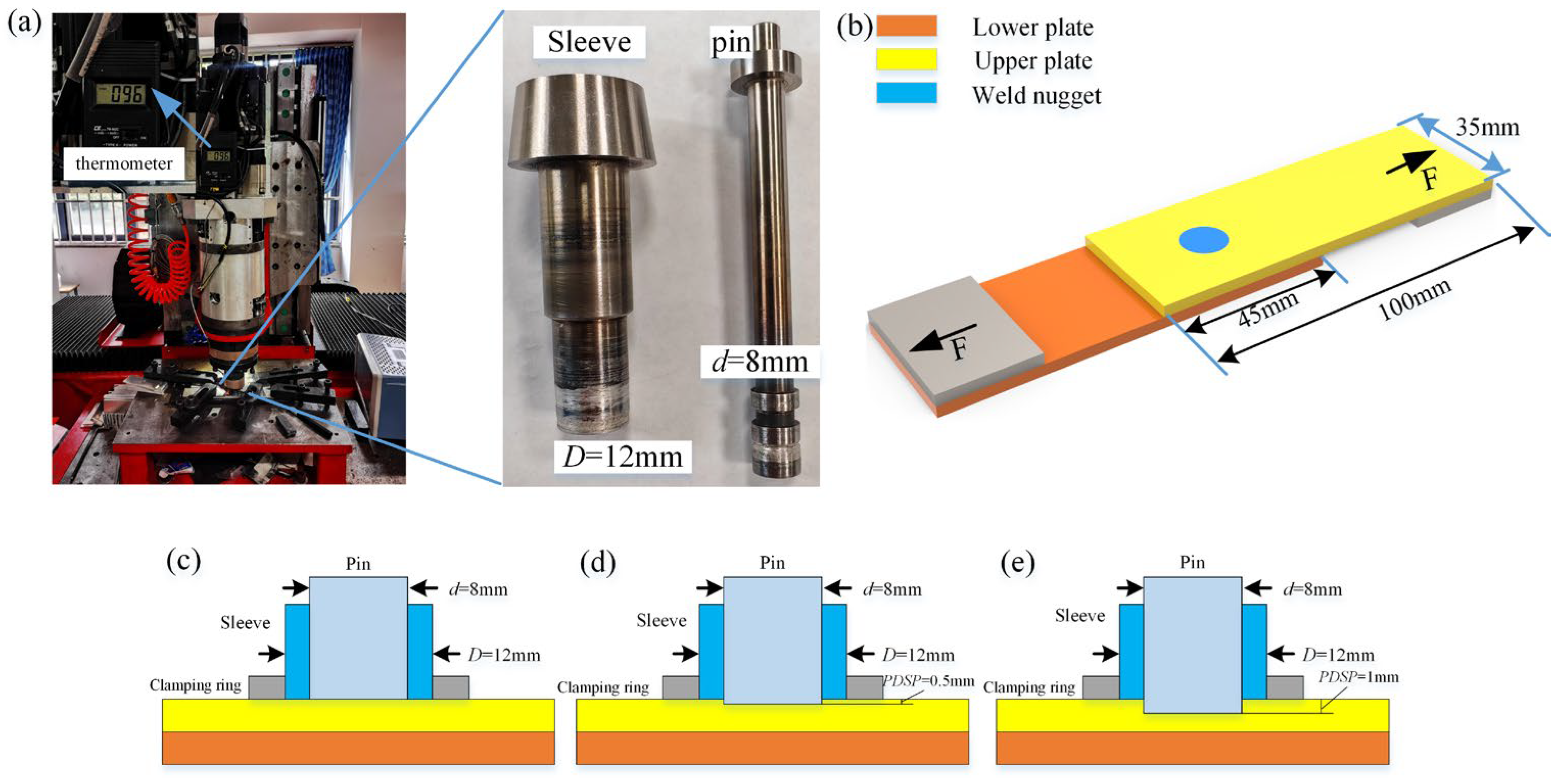

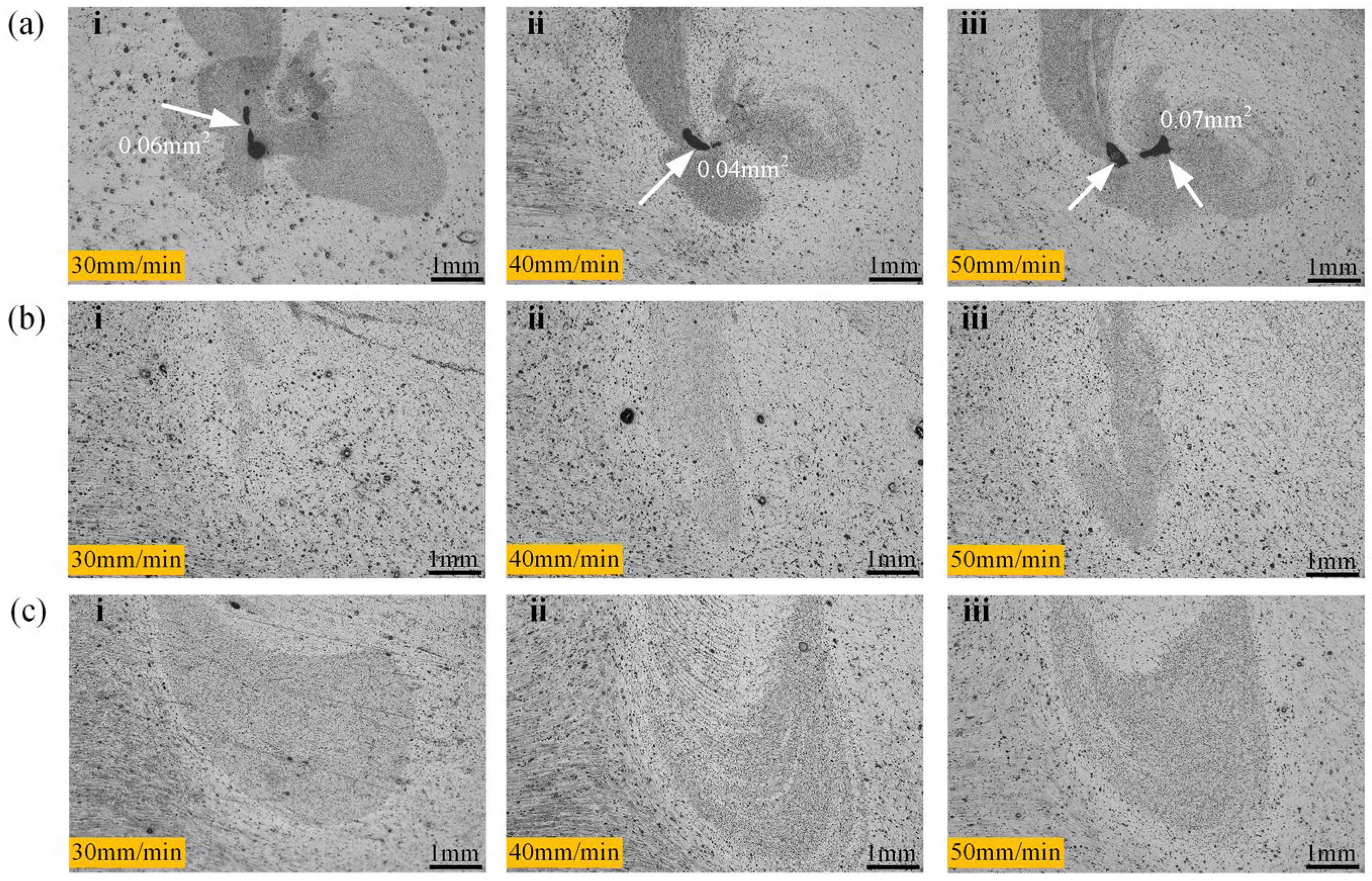

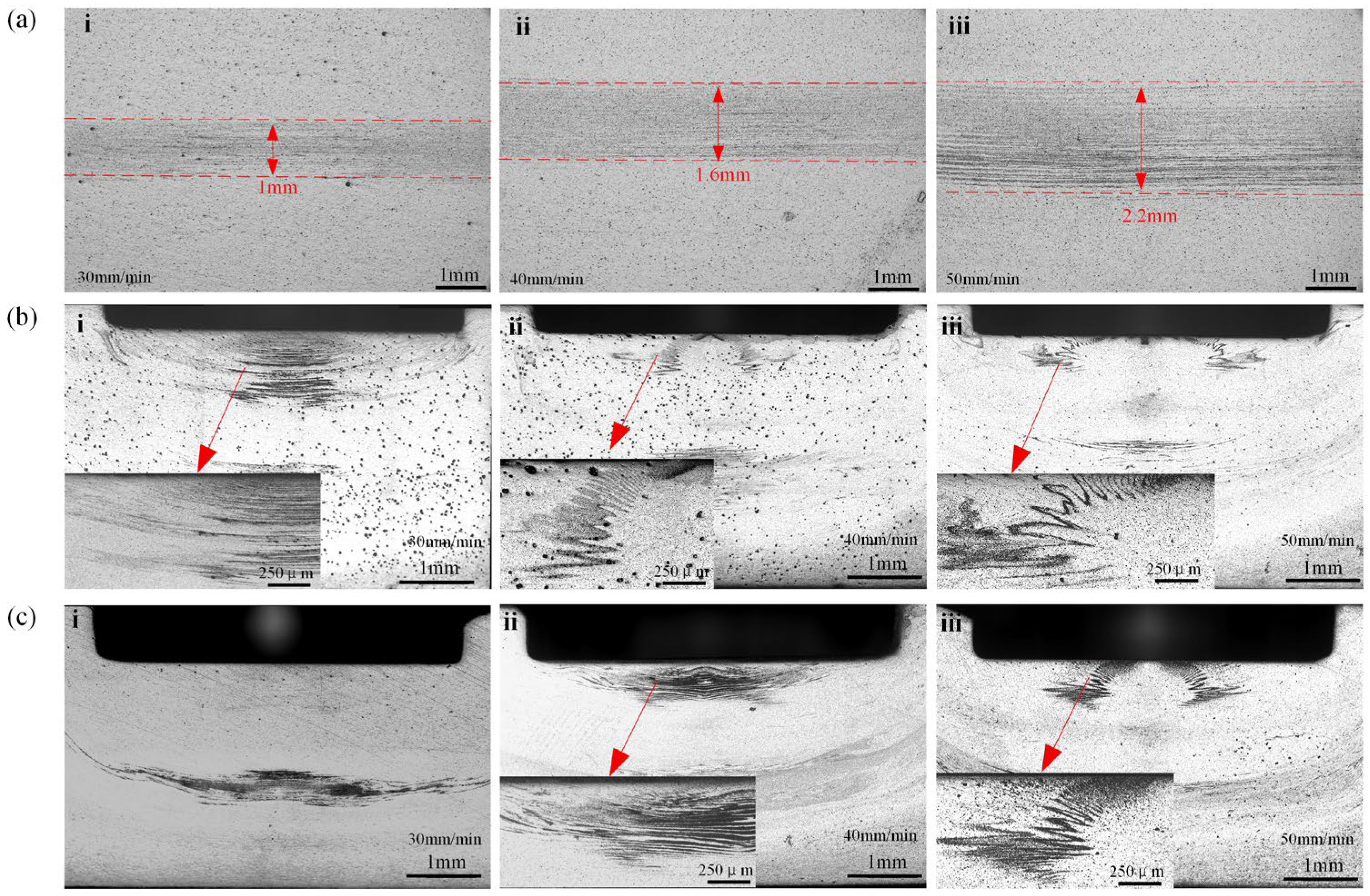
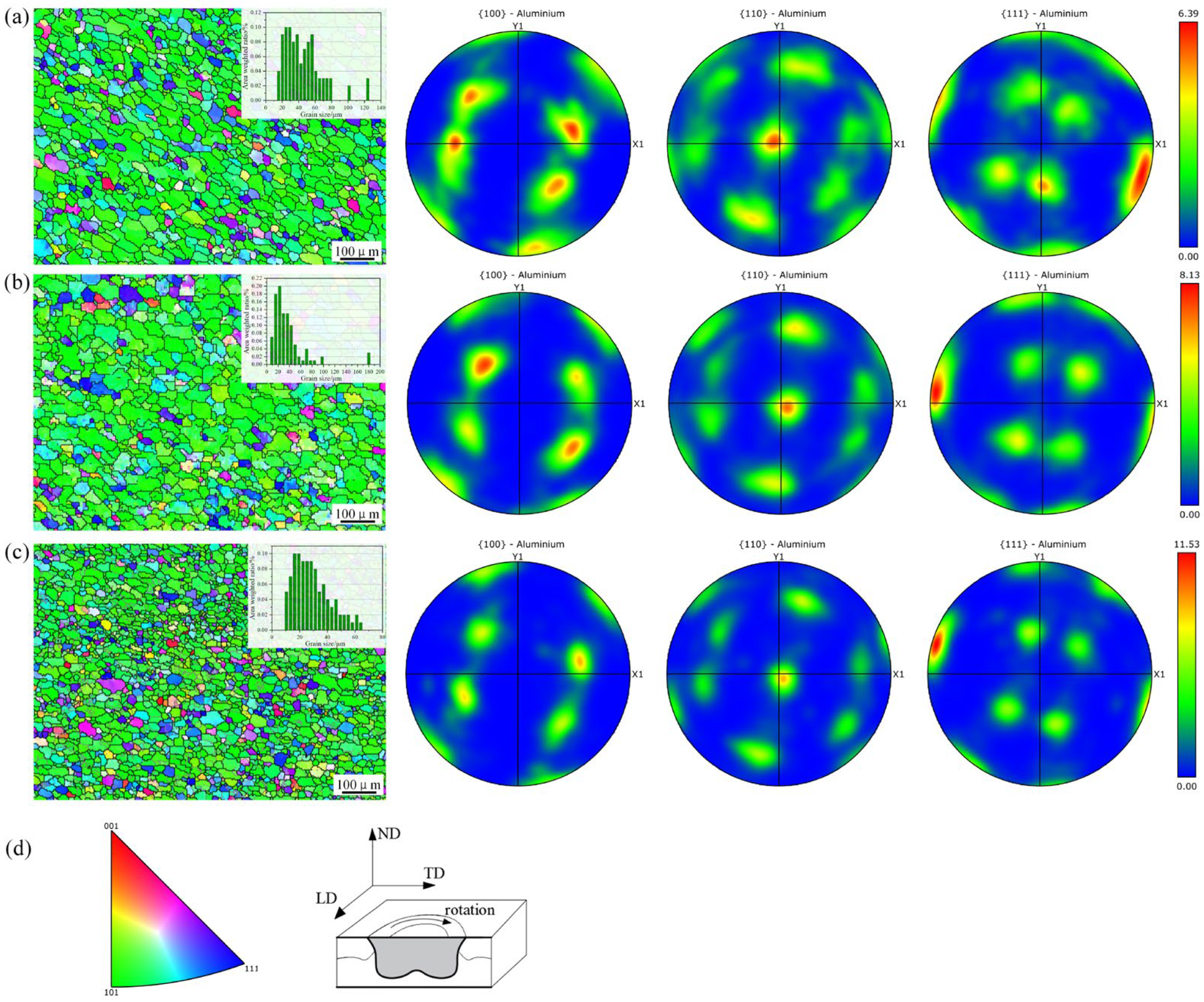
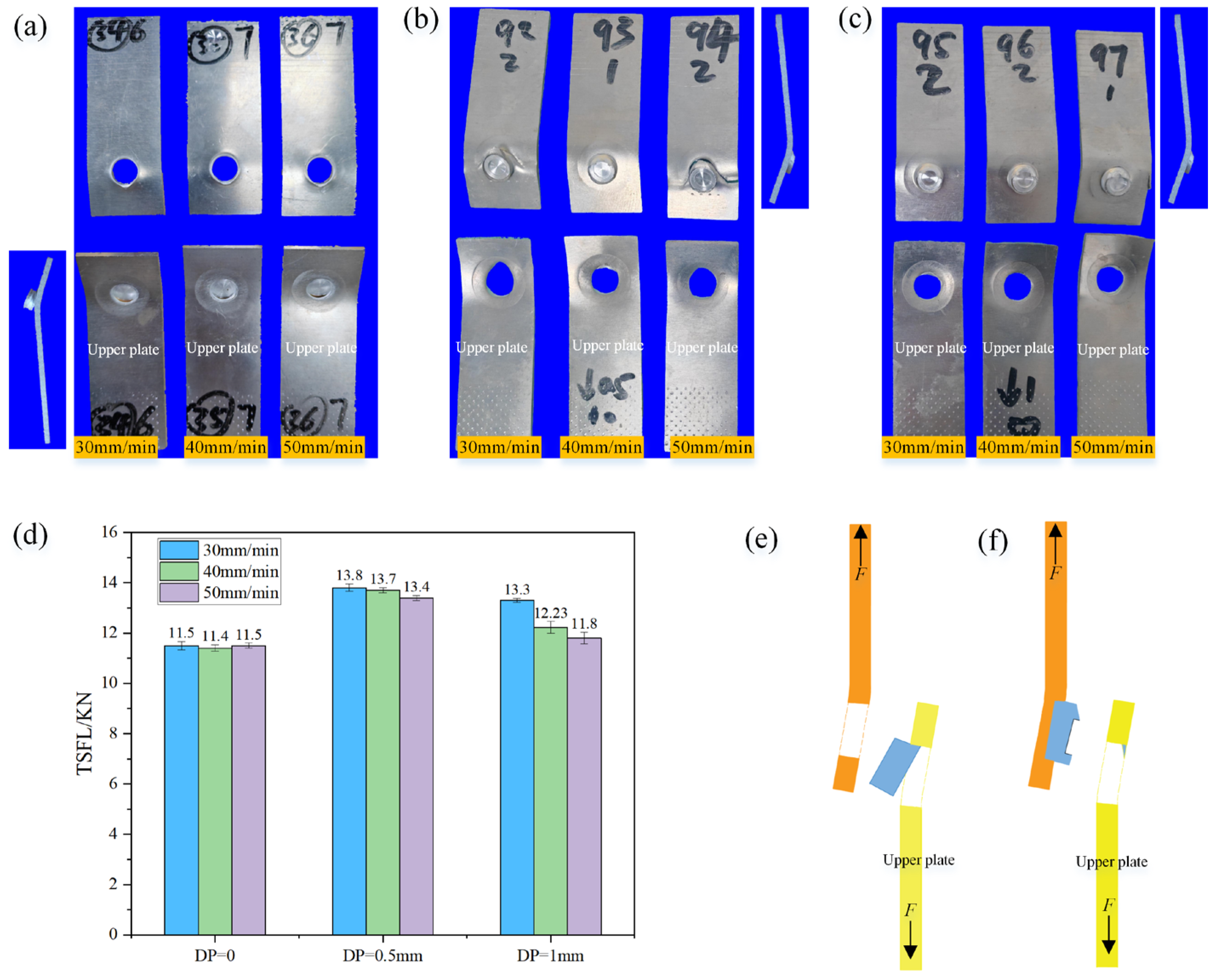

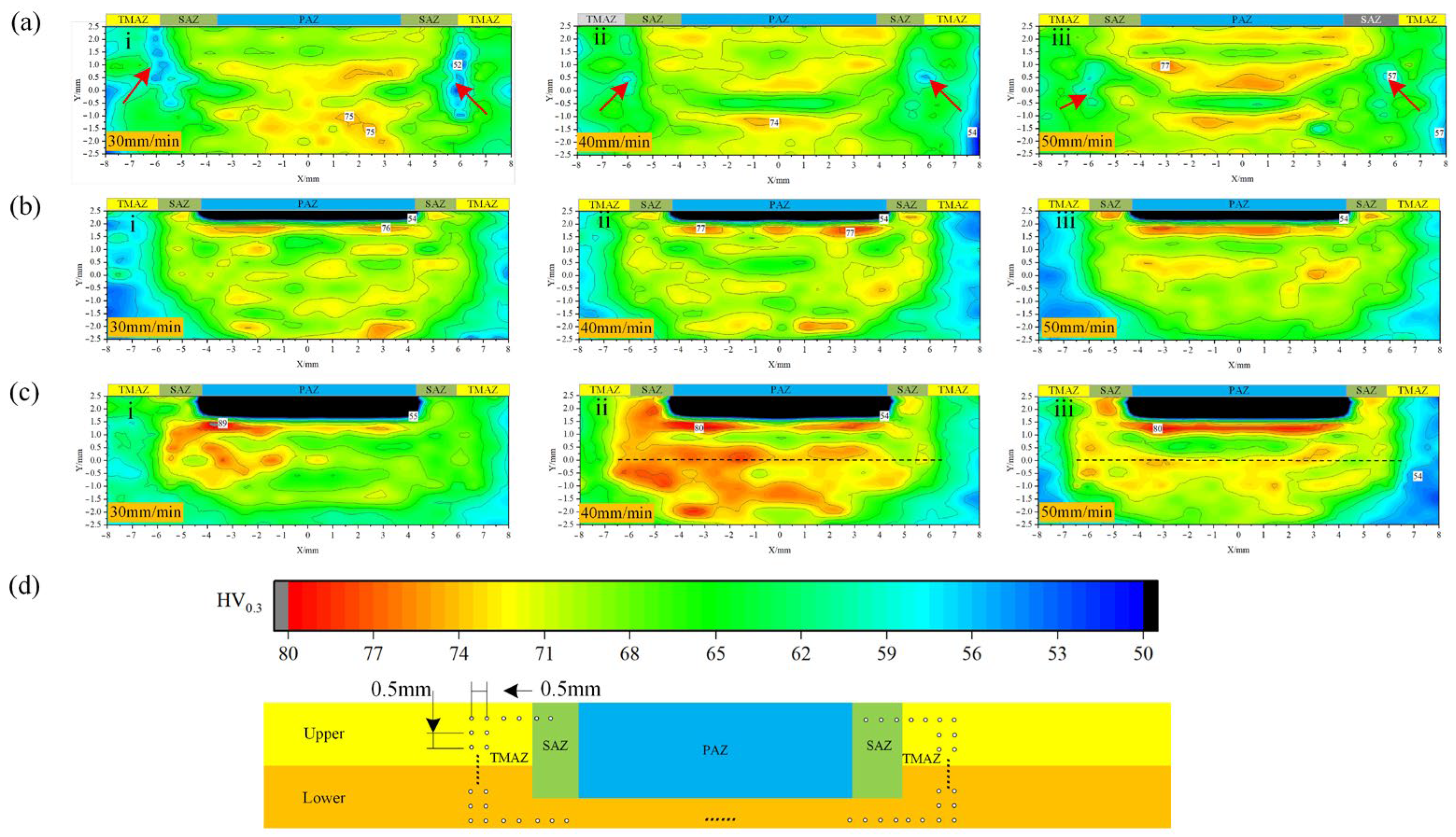
| Each Element’s Composition (wt) % | ||||||||
|---|---|---|---|---|---|---|---|---|
| Si | Fe | Cu | Cr | Mg | Mn | Ti | Zn | Al |
| 0.65 | 0.56 | 0.28 | 0.2 | 1.08 | 0.052 | 0.019 | 0.01 | Others |
| Tensile Strength/MPa | Elongation/% | Hardness/HV0.3 | Average Grains/μm |
|---|---|---|---|
| 304 | 14 | 92 | 55 |
Disclaimer/Publisher’s Note: The statements, opinions and data contained in all publications are solely those of the individual author(s) and contributor(s) and not of MDPI and/or the editor(s). MDPI and/or the editor(s) disclaim responsibility for any injury to people or property resulting from any ideas, methods, instructions or products referred to in the content. |
© 2025 by the authors. Licensee MDPI, Basel, Switzerland. This article is an open access article distributed under the terms and conditions of the Creative Commons Attribution (CC BY) license (https://creativecommons.org/licenses/by/4.0/).
Share and Cite
Jiang, D.; Kolupaev, I.; Wang, H.; Ge, X. Study on the Effect of the Plunging Depth of Stirring Pin on the Performance of 6061-T6 Aluminum Alloy Refill Friction Stir Spot Welded Zone. Materials 2025, 18, 3921. https://doi.org/10.3390/ma18163921
Jiang D, Kolupaev I, Wang H, Ge X. Study on the Effect of the Plunging Depth of Stirring Pin on the Performance of 6061-T6 Aluminum Alloy Refill Friction Stir Spot Welded Zone. Materials. 2025; 18(16):3921. https://doi.org/10.3390/ma18163921
Chicago/Turabian StyleJiang, Di, Igor Kolupaev, Hongfeng Wang, and Xiaole Ge. 2025. "Study on the Effect of the Plunging Depth of Stirring Pin on the Performance of 6061-T6 Aluminum Alloy Refill Friction Stir Spot Welded Zone" Materials 18, no. 16: 3921. https://doi.org/10.3390/ma18163921
APA StyleJiang, D., Kolupaev, I., Wang, H., & Ge, X. (2025). Study on the Effect of the Plunging Depth of Stirring Pin on the Performance of 6061-T6 Aluminum Alloy Refill Friction Stir Spot Welded Zone. Materials, 18(16), 3921. https://doi.org/10.3390/ma18163921






